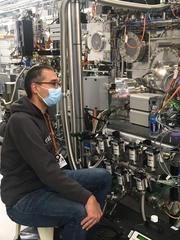URL: https://www.desy.de/news/news_search/index_eng.html
Breadcrumb Navigation
DESY News: First-ever X-ray attosecond experiment on liquids provides new insights into water’s molecular properties
News
News from the DESY research centre
First-ever X-ray attosecond experiment on liquids provides new insights into water’s molecular properties
An international team has performed an attosecond-scale experiment at an X-ray free-electron laser on liquid water for the first time, and the results may change our interpretation of water’s behaviour. The experiment team, led by scientist Linda Young from Argonne National Laboratory in the US, found an unusual signal when they examined liquid water using X-ray flashes that were timed a few hundred attoseconds (an attosecond is a billionth of a billionth of a second). A theory team led by Robin Santra, lead scientist at the research centre DESY and a professor at Universität Hamburg in Germany, and Xiaosong Li, a professor at the University of Washington in the US, used quantum-mechanical techniques for the analysis. Based on the data of the new experiment, they found that a longstanding measurement of the structure of liquid water has been misinterpreted. The effects of this finding not only demonstrate the potential of attosecond research on condensed matter at X-ray lasers, which is so far unprecedented, but also may require a rethink on how a wide range of molecules beyond water, especially organic ones, are structured. The findings have been published in the journal Science.

Georgi Dakovski operating the LCLS ChemRIXS beamline, where the experiment was carried out during the pandemic. (Image: Linda Young)
In parallel, scientists have developed techniques using lasers to study phenomena beyond the capability of XES – a field called attosecond science, for which in 2023 the Nobel Prize in Physics was awarded. The Linda Young-led experimental team, which used the LCLS X-ray laser at SLAC National Accelerator Laboratory in the US, managed to use X-ray attosecond pulse pairs, with the pulses within the pair timed a few hundred attoseconds apart from one another, to find a signal in conflict with XES data, which have been interpreted as showing two structural motifs in water. For the first time attosecond X-ray laser pulses were used to investigate non-gaseous matter.
To explain their odd result, Young’s team turned to theoretical physicists who could calculate and model what had happened. Santra, the head of the theory group at the Center for Free Electron Laser Science (CFEL) at DESY, considered a hypothesis in the theory community that hydrogen atoms in the water could be the deciding factor. “When X-rays pass through water, the hydrogen atoms, which are very light, can start moving,” Santra says. “That motion could be what was picked up in the XES measurement, rather than two different structures being detected.”
Santra’s team produced a model to examine how the experiment progressed at the level of the electrons. In contrast to XES measurements, where X-rays would knock out a low-energy inner electron and a higher energy outer electron would replace it, causing the hydrogen atoms to move, the LCLS experiment led exactly to the reverse: causing an inner electron to move further out. The theoretical model of Santra’s team showed that this difference kept the hydrogen from moving, in addition to the attosecond timing being faster than any motion of the hydrogen. “In effect, this worked as a switch to ‘turn off’ the movement of the hydrogen atom,” says Swarnendu Bhattacharyya, one of the first authors on the paper and a postdoc in Santra’s group.
“In principle, we cannot rule two structures out. However, they do not correspond to the two features seen in the XES measurement,” says Santra. “The motion of the hydrogen atoms in the water molecule generates this effect.” Moreover, if such an effect provides a result in XES measurements that invites error, it could mean this fundamental tool in looking at the structure of molecules, might need to be re-evaluated. This would be particularly important for the future understanding of molecules rich in hydrogen – including, crucially, hydrocarbons, comprising almost all molecules found in living things, almost all fuels we use, and chemicals vital to industry and everyday life.
“This experiment opens the door to attosecond X-ray laser science,” says Santra. Until now, most attosecond science has taken place using optical lasers on gas samples. “Using attosecond science techniques with optical lasers, this result would not have been possible. Now this team has shown a way to adapt attosecond techniques to condensed matter with much brighter light, and it has already revealed something potentially significant about our understanding of matter – that with XES measurements we may not be getting the whole picture of matter as it exists in nature.”
DESY’s experience and techniques were crucial in this result and form a cornerstone towards the future Centre for Molecular Water Science (CMWS) that DESY is setting up. The experimental and theoretical teams for this result comprise scientists from Argonne National Laboratory, the University of Washington, Pacific Northwest National Laboratory, Washington State University, the University of Chicago, and SLAC National Accelerator Laboratory, all in the US; and DESY, Universität Hamburg, and the Hamburg Cluster of Excellence “CUI: Advanced Imaging of Matter,” all in Germany.
Original paper:
Attosecond-pump attosecond-probe x-ray spectroscopy of liquid water; Shuai Li, Lixin Lu, Swarnendu Bhattacharyya et al.
Science, DOI: 10.1126/science.adn6059



